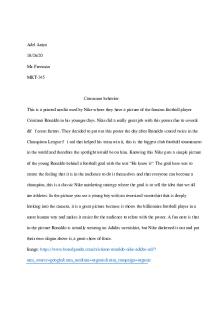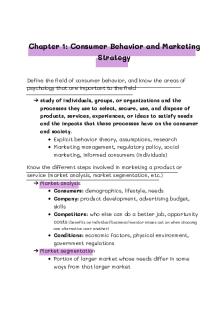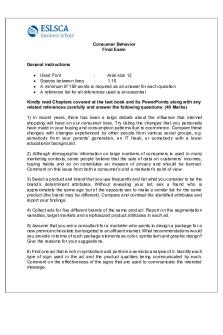Consumer Behavior Buying, Having, and Being, EBook PDF

| Title | Consumer Behavior Buying, Having, and Being, EBook |
|---|---|
| Author | Niva Asiata |
| Course | Consumer Behaviour |
| Institution | Auckland University of Technology |
| Pages | 4 |
| File Size | 217.3 KB |
| File Type | |
| Total Downloads | 8 |
| Total Views | 147 |
Summary
Little bit of notes from the E-book textbook....
Description
106
Section 2
• Internal Influences on Consumer Behavior
than non-players. They say the games can improve reaction and the ability to pick out details amid clutter. For better or worse, technology seems to be rewiring our brains to try to pay attention to more stimuli. Today we consume three times as much information each day as people did in 1960. We constantly shift attention: Computer users at work change windows or check email or other programs nearly 37 times an hour. Computer users visit an average of 40 websites a day.63 Marketers constantly search for ways to break through the clutter and grab people’s attention. Some tactics are straightforward, such as when manufacturers try to get their brands shelved at eye level in a store and toward the center of a display because they know that is where shoppers are most likely to look.64 In the online world, advertisers keep innovating to get visitors to watch their messages. One of the most popular today is rich media—the use of animated gif files or video clips to grab viewers’ attention. LowerMyBills.com is notorious for its endless loops of silhouetted dancers and surprised office workers, whereas other ads spring into action when you move the cursor over them. AG Jeans for example, allows you to build an outfit on your phone “tap”? for phone? Other rich media are online versions of familiar TV commercials that sit frozen on the website until you click them. Teaser ads, much like those you see on TV that give you a taste of the story but make you return later for the rest, also turn up on websites.65 Because the brain’s capacity to process information is limited, consumers are selective about what they pay attention to. The process of perceptual selection means that people attend to only a small portion of the stimuli to which they are exposed. Consumers practice a form of “psychic economy” as they pick and choose among stimuli to avoid being overwhelmed. How do we choose? Both personal and stimulus factors help to decide.
Copyright © 2019. Pearson Education, Limited. All rights reserved.
Personal Selection Factors How do marketers seem to “know” when you’re hungry and choose those times to bombard you with food ads? The answer is they don’t—at least not yet. Perceptual vigilance means we are more likely to be aware of stimuli that relate to our current needs. The flip side of perceptual vigilance is perceptual defense. This means that we tend to see what we want to see—and we don’t see what we don’t want to see. If a stimulus threatens us in some way, we may not process it, or we may distort its meaning so that it’s more acceptable. For example, a heavy smoker may block out images of cancer-scarred lungs because these vivid reminders hit a bit too close to home. Still another factor is adaptation, which is the degree to which consumers continue to notice a stimulus over time. The process of adaptation occurs when we no longer pay attention to a stimulus because it is so familiar. A consumer can “habituate” and require increasingly stronger “doses” of a stimulus to notice it. A commuter who is en route to work might read a billboard message when the board is first installed, but after a few days it simply becomes part of the passing scenery. Several factors can lead to adaptation:
• • • •
Intensity—Less-intense stimuli (e.g., soft sounds or dim colors) habituate because they have less sensory impact. Discrimination—Simple stimuli habituate because they do not require attention to detail. Exposure—Frequently encountered stimuli habituate as the rate of exposure increases. Relevance—Stimuli that are irrelevant or unimportant habituate because they fail to attract attention.
Solomon, M. (2019). Consumer behavior : Buying, having, and being, ebook, global edition. ProQuest Ebook Central http://ebookcentral.proquest.com Created from aut on 2021-09-01 23:52:27
Chapter 3
• Perception
107
Is this dress white and gold, or blue and black? Many people engaged in a fierce online debate about the answer. Which colors do you see? Hint: The company that made the dress describes it on its website as “Royal Blue.” Source: Amina Khan/National Science Foundation.
Stimulus Selection Factors In addition to the receiver’s mind-set, characteristics of the stimulus itself play an important role to determine what we notice and what we ignore. Marketers need to understand these factors so they can create messages and packages that will have a better chance to cut through the clutter. For example, when researchers used infrared eye-tracking equipment to measure what ads consumers look at, they found that visually complex ads are more likely to capture attention.66 In general, we are more likely to notice stimuli that differ from others around them (remember Weber’s Law). A message creates contrast in several ways:
•
Copyright © 2019. Pearson Education, Limited. All rights reserved.
•
•
Size—The size of the stimulus itself in contrast to the competition helps to determine if it will command attention. Readership of a magazine ad increases in proportion to the size of the ad.67 Color—As we’ve seen, color is a powerful way to draw attention to a product or to give it a distinct identity. Black & Decker developed a line of tools it called DeWalt to target the residential construction industry. The company colored the new line yellow instead of black; this made the equipment stand out against other “dull” tools.68 Position—Not surprisingly, we stand a better chance of noticing stimuli that are in places where we’re more likely to look. That’s why the competition is so heated among suppliers to have their products displayed in stores at eye level. In magazines, ads that are placed toward the front of the issue, preferably on the right-hand side, also win out in the race for readers’ attention. (Hint: The next time you read a magazine, notice which pages you’re more likely to spend time looking at.)69 Astudy that tracked consumers’ eye movements as they scanned telephone directories also illustrated the importance of message position. Consumers scanned listings in alphabetical order, and they noticed 93 percent of quarter-page display ads but only 26 percent of plain listings. Their eyes were drawn to color ads first, and these were viewed longer than black-and-white ones. In addition, subjects spent 54 percent more time viewing ads for businesses they ended up choosing, which illustrates the influence of attention on subsequent product choice.70 Another study reported that advertisers can increase brand recall and choice if they change the location of brand logos and product depictions across ad exposures.71
Solomon, M. (2019). Consumer behavior : Buying, having, and being, ebook, global edition. ProQuest Ebook Central http://ebookcentral.proquest.com Created from aut on 2021-09-01 23:52:27
108
Section 2
• Internal Influences on Consumer Behavior
Copyright © 2019. Pearson Education, Limited. All rights reserved.
•
And products that are located in the center of a person’s field of vision are more likely to receive attention.72 Position also is important in online advertising. Sophisticated eye-tracking studies clearly show that most search engine users view only a limited number of search results. When the typical shopper looks at a search page, his or her eye travels across the top of the search result, returns to the left of the screen, and then travels down to the last item shown on the screen without scrolling. Search engine marketers call this space on the screen where we are virtually guaranteed to view listings the golden triangle (see Figure 3.3).73 Novelty—Stimuli that appear in unexpected ways or places tend to grab our attention. Packages that “stand out” visually on store shelves have an advantage, especially when the consumer doesn’t have a strong preference for brands in the
Figure 3.3 THE GOLDEN TRIANGLE Eye-tracking studies reveal that people typically spend most of their time on a website looking at the “golden triangle” outlined by yellow, orange and red. Source: Enquiro Search Solutions, Inc. (Now Mediative Performance LP). Solomon, M. (2019). Consumer behavior : Buying, having, and being, ebook, global edition. ProQuest Ebook Central http://ebookcentral.proquest.com Created from aut on 2021-09-01 23:52:27
Chapter 3
• Perception
category and he or she needs to make rapid decisions.74 One solution is to put ads in unconventional places, where there will be less competition for attention. These places include the backs of shopping carts, walls of tunnels, floors of sports stadiums, and yes, even public restrooms.75 An outdoor advertising agency in London constructs huge ads in deserts and farm fields adjacent to airports so that passengers who look out the window can’t help but pay attention. It prints the digital ads on pieces of PVC mesh that sit on frames a few inches above the ground.76 Indeed, one study indicates that novelty in the form of interruptions actually intensifies our experiences; distraction increases our enjoyment of pleasant stimuli because it amplifies our dislike of unpleasant stimuli. According to this research, people actually enjoy TV shows more when commercials interrupt them. A group of undergraduates watched an episode of an old sitcom (Taxi) with which they were unfamiliar. Half viewed the original broadcast, which included ads for a jeweler, a lawyer, and other businesses; the other half saw the show with all commercials deleted. Students who saw the original actually gave it higher evaluations. The researchers found a similar pattern when they interrupted people who were getting a massage. In contrast, subjects reported that the irritating sound of a vacuum cleaner was even worse when they got a break from listening to it and then had to hear it resume! The researchers interpret these results as the outcome of adaptation: We experience events more intensely at first but then get used to them. When we experience an interruption and then start over, we revert to the original intensity level.77
Copyright © 2019. Pearson Education, Limited. All rights reserved.
Stage 3: Interpretation Interpretation refers to the meanings we assign to sensory stimuli. Just as people differ in terms of the stimuli that they perceive, the meanings we assign to these stimuli vary as well. Many of these meanings depend on our socialization within a society: Even sensory perception is culturally specific. A team of anthropologists created a “kit” of stimuli to compare what people around the world perceive; this included color chips, scratch-and-sniff cards, sounds recorded at different frequencies, and so on. When they exposed the same stimuli to people in more than 20 different cultures, the results were dramatic: For example, prior research on mostly English-speaking people indicated that the typical person is not good at identifying the smell of everyday things like coffee, peanut butter, and chocolate; they usually identify about half of them correctly. However, people who live on the Malay Peninsula were more accurate. Language differences drive some of these contrasts. The researchers found that English and Dutch speakers used different metaphors than Farsi and Turkish people to describe pitch; the latter think of sounds as thin or thick rather than high or low. When Dutch speakers heard a tone while they were shown a mismatched height bar (e.g., a high tone and a low bar) and were asked to sing the tone, they sang a lower tone—but this wasn’t the case when they saw a thin or thick bar. In contrast, when Farsi speakers heard a tone and were shown a bar of mismatched thickness, they misremembered the tone but not when they were shown a bar mismatched for height.78As we’ll see in Chapter 14, culture matters—a lot. Two people can see or hear the same event, but their interpretation of it can be as different as night and day, depending on what they had expected the stimulus to be. In one study, children aged three to five who ate McDonald’s French fries served in a McDonald’s bag overwhelmingly thought they tasted better than those who ate the same fries out of a plain white bag. Even carrots tasted better when they came out of a McDonald’s bag—more than half the kids preferred them to the same carrots served in a plain package! Ronald would be proud.79
Solomon, M. (2019). Consumer behavior : Buying, having, and being, ebook, global edition. ProQuest Ebook Central http://ebookcentral.proquest.com Created from aut on 2021-09-01 23:52:27
109...
Similar Free PDFs

Consumer Buying Behavior
- 3 Pages

CONSUMER BUYING BEHAVIOUR
- 6 Pages

Consumer behavior
- 5 Pages

Consumer Behavior
- 33 Pages

Unit 5- Business Buying Behavior
- 2 Pages

Lecture 6 Consumer Behavior
- 2 Pages

Consumer Behavior Final Exam
- 2 Pages

MCQs-Consumer-Behavior
- 24 Pages
Popular Institutions
- Tinajero National High School - Annex
- Politeknik Caltex Riau
- Yokohama City University
- SGT University
- University of Al-Qadisiyah
- Divine Word College of Vigan
- Techniek College Rotterdam
- Universidade de Santiago
- Universiti Teknologi MARA Cawangan Johor Kampus Pasir Gudang
- Poltekkes Kemenkes Yogyakarta
- Baguio City National High School
- Colegio san marcos
- preparatoria uno
- Centro de Bachillerato Tecnológico Industrial y de Servicios No. 107
- Dalian Maritime University
- Quang Trung Secondary School
- Colegio Tecnológico en Informática
- Corporación Regional de Educación Superior
- Grupo CEDVA
- Dar Al Uloom University
- Centro de Estudios Preuniversitarios de la Universidad Nacional de Ingeniería
- 上智大学
- Aakash International School, Nuna Majara
- San Felipe Neri Catholic School
- Kang Chiao International School - New Taipei City
- Misamis Occidental National High School
- Institución Educativa Escuela Normal Juan Ladrilleros
- Kolehiyo ng Pantukan
- Batanes State College
- Instituto Continental
- Sekolah Menengah Kejuruan Kesehatan Kaltara (Tarakan)
- Colegio de La Inmaculada Concepcion - Cebu







